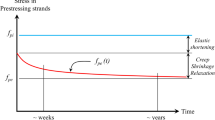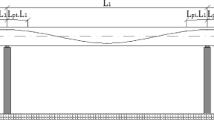Abstract
The paper describes the reliability-based optimization of TT shaped precast roof girder produced in Austria. Extensive experimental studies on small specimens and small and full-scale beams have been performed to gain information on fracture mechanical behaviour of utilized concrete. Subsequently, the destructive shear tests under laboratory conditions were performed. Experiments helped to develop an accurate numerical model of the girder. The developed model was consequently used for advanced stochastic analysis of structural response followed by reliability-based optimization to maximize shear and bending capacity of the beam and minimize production cost under defined reliability constraints. The enormous computational requirements were significantly reduced by the utilization of artificial neural network-based approximations of the original nonlinear finite element model of optimized structure.
Access this chapter
Tax calculation will be finalised at checkout
Purchases are for personal use only
Similar content being viewed by others
References
Frangopol, D.M.: Interactive reliability based structural optimization. Comput. Struct. 19(4), 559–563 (1984)
Li, W., Yang, L.: An effective optimization procedure based on structural reliability. Comput. Struct. 52(5), 1061–1071 (1994)
Beck, A.T., Gomes, W.J.S.: A comparison of deterministic, reliability-based and risk-based structural optimization under uncertainty. Probab. Eng. Mech. 28, 18–29 (2012)
Beyer, H.G., Sendhoff, B.: Robust optimization – a comprehensive survey. Comput. Methods Appl. Mech. Eng. 196, 3190–3218 (2007)
Aoues, Y., Chateauneuf, A.: Benchmark study of numerical methods for reliability-based design optimization. Struct. Multidisc. Optim. 41(2), 277–294 (2010)
Tu, J., Choi, K.K.: A new study on reliability-based design optimization. J. Mech. Des. (ASME) 121(4), 557–564 (1999)
da Silva, G.A., Beck, A.T., Sigmund, O.: Stress-constrained topology optimization considering uniform manufacturing uncertainties. Comput. Methods Appl. Mech. Eng. 344, 512–537 (2018). https://doi.org/10.1016/j.cma.2018.10.020
CEN: Eurocode 2: Design of Concrete Structures—Part 1-1: General Rules and Rules for Buildings. European Committee for Standardization – ECS (2004)
Strauss, A., Zimmermann, T., Lehký, D., Novák, D., Keršner, Z.: Stochastic fracture-mechanical parameters for the performance-based design of concrete structures. Struct. Concr. 15(3), 380–394 (2014)
Lehký, D., Keršner, Z., Novák, D.: FraMePID-3PB software for material parameters identification using fracture test and inverse analysis. Adv. Eng. Softw. 72, 147–154 (2014)
Stoerzel, J., Randl, N., Strauss, A.: Monitoring shear degradation of reinforced and pre-tensioned concrete members. In: IABSE Conference, Geneva (2015)
Strauss, A., Krug, B., Slowik, O., Novak, D.: Combined shear and flexure performance of prestressing concrete T-shaped beams: experiment and deterministic modelling. Struct. Concr. 1–20 (2017). https://doi.org/10.1002/suco.201700079
Slowik, O., Novák, D., Strauss, A., Krug, B.: Stochastic analysis of precast structural members failing in shear. In: Proceedings of 12th fib International Ph.D. Symposium in Civil Engineering, Prague, pp. 617–624 (2018). ISBN 978-80-01-06401-6
Červenka, V., Jendele, L., Červenka, J.: ATENA program documentation – part 1: theory, Červenka Consulting, Prague, Czech Republic (2019)
Taerwe, L., Matthys, S.: Fib Model Code for Concrete Structures 2010. Ernst & Sohn, Wiley, Berlin (2013)
McKay, M.D., Conover, W.J., Beckman, R.J.: A comparison of three methods for selecting values of input variables in the analysis of output from a computer code”. Technometrics 21, 239–245 (1979)
Strauss, A., Krug, B., Slowik, O., Novak, D.: Prestressed concrete roof girders: part I – deterministic and stochastic model. In: Proceedings of the Sixth International Symposium on Life-Cycle Civil Engineering (IALCCE 2018), vol. 1, pp. 510–517. CRC press, Taylor and Francis Group, London (2018). ISBN 9781138626331
Cheng, L., Zhenzhou, L., Leigang, Z.: New spearman correlation based sensitivity index and its unscented transformation solutions. J. Eng. Mech. 142, 04015076 (2015). https://doi.org/10.1061/(ASCE)EM.1943-7889.0000988
Lehký, D., Šomodíková, M.: Reliability calculation of time-consuming problems using a small-sample artificial neural network-based response surface method. Neural Comput. Appl. 28(6), 1249–1263 (2016). https://doi.org/10.1007/s00521-016-2485-3
Cornell, C.A.: A Probability-based structural code. ACI J. 66, 974–985 (1969)
Acknowledgment
The authors would like to express their thanks for the support provided by the Czech Science Foundation (GAČR) Project RESUS No. 18-13212S and the project TAČR DELTA No. TF06000016.
Author information
Authors and Affiliations
Corresponding author
Editor information
Editors and Affiliations
Rights and permissions
Copyright information
© 2020 Springer Nature Switzerland AG
About this paper
Cite this paper
Slowik, O., Lehký, D., Novák, D. (2020). Combinatorial Reliability-Based Optimization of Nonlinear Finite Element Model Using an Artificial Neural Network-Based Approximation. In: Nicosia, G., et al. Machine Learning, Optimization, and Data Science. LOD 2020. Lecture Notes in Computer Science(), vol 12565. Springer, Cham. https://doi.org/10.1007/978-3-030-64583-0_33
Download citation
DOI: https://doi.org/10.1007/978-3-030-64583-0_33
Published:
Publisher Name: Springer, Cham
Print ISBN: 978-3-030-64582-3
Online ISBN: 978-3-030-64583-0
eBook Packages: Computer ScienceComputer Science (R0)




